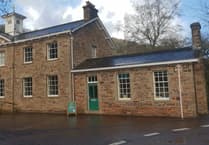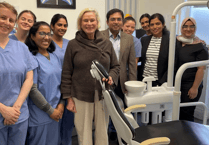ANCIENT iron workers in West Somerset were so wealthy they could afford fine pottery from France and storage vessels from Spain, according to the results of an archaeological dig on the shores of Clatworthy Reservoir. The results of May's excavations have only just been made public and seem to prove the existence of Roman iron-working in the Brendon Hills. A small team of volunteers led by Lee Bray, of Exeter University, and accompanied by former Nettlecombe Court worker Simon Ratsey, dug through layers of smelting slag by the reservoir to retrieve some 150 artefacts. The finds included pieces of locally-made pottery, others came from Poole in Dorset, while there were fragments of a finely-decorated bowl made in central France and pieces of amphora, a large storage vessel made in southern Spain. All the pieces seemed to date from the late first to mid second century AD. Mr Ratsey, who first found evidence of a Roman settlement in the area in the early 1970s when he identified Roman pottery near Five Bells, said he had waited more than 30 years to take part in such a dig. "I was really pleased to find the first fragment of pottery in situ proving the slag heap to be from the Roman period," he said. "I also made the very last find at the bottom of the trench - a fragment of glass that has been verified as Roman window glass by experts at Durham University." He said the glass fragment raised some particularly interesting questions, especially as a fragment of brick or tile had also been found. Dig supervisor and specialist researcher Mr Bray said the two items might imply the presence of a building constructed in a Roman architectural style using Roman building materials. "Such a building could be one of only two things, a dwelling or a bath house," he said. "Support for this theory is gained from finds during a field survey of fragments of tile, nails and a tile from a hypocaust or Roman central heating system. "However, these came from a location at least 400 metres from the excavation so that could mean there have been two Roman-style buildings at Clatworthy." He said whatever the answer, the most significant conclusion from the dig was the status of the people who worked the iron ore. "At a time when West Somerset was under the rule of Rome and the Empire was reaching its zenith, iron workers in the area had considerable wealth and status," he said. "They could afford fine pottery from France, amphorae of olives from Spain and glass drinking vessels and, maybe, were even able to construct in expensive Roman styles." There are no current plans to carry out further excavations at the site and the team thanked Somerset County Council and Wessex Water for allowing the dig to take place.



